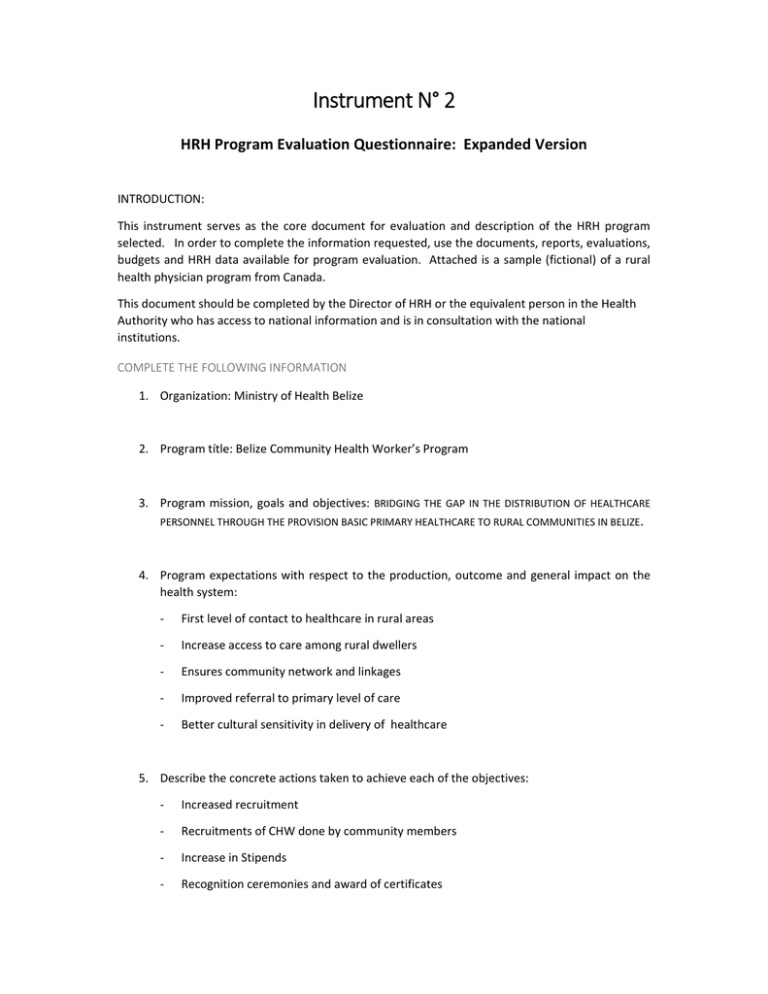Instrument N° 2 HRH Program Evaluation Questionnaire: Expanded Version
advertisement

Instrument N° 2 HRH Program Evaluation Questionnaire: Expanded Version INTRODUCTION: This instrument serves as the core document for evaluation and description of the HRH program selected. In order to complete the information requested, use the documents, reports, evaluations, budgets and HRH data available for program evaluation. Attached is a sample (fictional) of a rural health physician program from Canada. This document should be completed by the Director of HRH or the equivalent person in the Health Authority who has access to national information and is in consultation with the national institutions. COMPLETE THE FOLLOWING INFORMATION 1. Organization: Ministry of Health Belize 2. Program títle: Belize Community Health Worker’s Program 3. Program mission, goals and objectives: BRIDGING THE GAP IN THE DISTRIBUTION OF HEALTHCARE PERSONNEL THROUGH THE PROVISION BASIC PRIMARY HEALTHCARE TO RURAL COMMUNITIES IN BELIZE. 4. Program expectations with respect to the production, outcome and general impact on the health system: ‐ First level of contact to healthcare in rural areas ‐ Increase access to care among rural dwellers ‐ Ensures community network and linkages ‐ Improved referral to primary level of care ‐ Better cultural sensitivity in delivery of healthcare 5. Describe the concrete actions taken to achieve each of the objectives: ‐ Increased recruitment ‐ Recruitments of CHW done by community members ‐ Increase in Stipends ‐ Recognition ceremonies and award of certificates DESCRIPCIÓN DEL PROGRAMA – versión 10 mayo 2013 ‐ Re‐training of care givers ‐ Partnership with US Peace Corps 6. Short, medium and long‐term goals and indicators for each of the objectives: ‐ Increase in referral of cases ‐ Decrease maternal mortality and infant mortality ‐ Decrease in morbidity of chronic illness 7. Describe the context in which the program was developed: This program was developed in response to the shortage of health workers within the rural Belize especially the hard to reach areas. 8. Describe the magnitude of the HRH problems that the program covers: The CHW program covers a wide range of HRH related problems. They are the base of the primary healthcare, filling the gaps created by health workforce shortages. They are members of the communities where they work, recruited by their own people such that retention is assured. They are also culturally competent and as such can deliver culturally sensitive care within their community. They are familiar with their terrain so that they provide the guide to mobile clinic teams and in time of immunization campaign. 9. Identify which of the 20 HRH Goals are linked to the program: Challenges 1. Policies & Plans 2. Sufficient personnel in the right places Goals 1. Density / geographic distribution 2. Proportion of doctors in PHC 3. Existence of PHC teams 4. Ratio nurse / doctor 5. National HRH unit with national steering role capacity 6. Rural / urban gap of doctors and nurses 7. Proportion of workers in PHC with public health competencies 8. Proportion of technical and auxiliary personnel with continuing education options DESCRIPCIÓN DEL PROGRAMA – versión 10 mayo 2013 3. Migration 4. Work conditions 5. Education‐ service links 9. PHC personnel recruited from their own communities 10. Adoption of the Code of Practice on the International Recruitment of Health Personnel 11. Policy on self‐sufficiency of HRH 12. Mutual agreements for recognizing professional practice 13. Proportion of precarious work conditions 14. Worker health and security policies 15. Managers with public health and management competencies 16. Conflict negotiation 17. Reorientation of training health personnel towards PHC 18. Training programs in health for under‐ served populations 19. Level of attrition in medical schools 20. Accreditation of medical and public health schools 10. Identify the health services program that is affiliated or supports the goal or goals: ‐ The Primary Health Care ‐ Mobile Clinic services 11. Detail the PROGRAM budget by component: The program is under HECOPAB with below budget from 2005/2006 to 2012/13 fiscal year. HECOPAB pilots the affairs of CHWs among other things, from this lean budget. Financial Year GoB’s Budget 2005/2006 2006/2007 2007/2008 2008/2009 2009/2010 2010/2011 2011/2012 2012/2013 493.7 561.7 585.2 649.6 768.5 825.0 867.4 862.2 61.5 72.8 86.4 72.8 83.4 95.5 97.8 93.7 12.5 13.0 14.8 11.2 10.9 11.6 11.3 10.9 (BZ $ M) MoH Budget (BZ $ M) MoH Budget (%) of GoB DESCRIPCIÓN DEL PROGRAMA – versión 10 mayo 2013 HECOPAB NA NA NA $127,151 $122,659 $179,464 $171,752 $153,944 HECOPAB as % of MoH NA NA NA 0.17 0.15 0.19 0.18 0.17 12. Indicate if the program is under development, has already begun, is now operational, or has already ended: The CHWs program has been operational since 1982. It was however restructured in 1995 after the creation of HECOPAB Unit. In 2012/2013 the HECOPAB initiated a partnership with US Peace Corp that would see the Corp member work with CHW at community level. 13. How long has the program been operational: Since 1982 14. Provide the program calendar: All year round calendar 15. List the partners participating in the program and its implementation: ‐ MOH, ‐ US Peace Corps 16. Identify the partners and interested parties who have been affected by the program, including all of the beneficiaries: ‐ The rural communities ‐ The vulnerable group within the community ‐ Underserved population ‐ Indigenous people 17. Describe the follow‐up or evaluation process in relation to the program: The HECOPAB Unit is under the headship of a competent Technical Adviser who is making concerted efforts to develop relevant indicators, set goals and commence Monitoring and Evaluation on regular basis. DESCRIPCIÓN DEL PROGRAMA – versión 10 mayo 2013 18. EXAMPLE OF RURAL HEALTH PHYSICIAN PROGRAM (RHPP), CANADA Objectives The program mission is to expand medical clinical rotations in rural zones, connecting medical students with doctors who work in small towns and remote areas. The principal objectives of the program are to: i) Support and promote students’ interest in careers in rural areas; ii) Provide opportunities for students to experience the challenges and rewards of working in rural practice; iii) Develop a mentor relationship between students and professionals in rural areas; iv) Encourage students to enter careers in primary health care; and v) Establish work‐learning partnerships between rural physicians, medical schools and students. Population of Interest The population of principal interest is medical students in years 1‐4 of medical school. Program partners include the medical schools, rural health clinics, rural hospitals, rural medical preceptors, other members of the local health professional team and patients. Long‐term Objectives and Outcomes Indicators Improve the health of the rural populations Annual variation % in the waiting‐time for through better access to medical services. patients in rural areas. Annual variation % in the amount of time that newly‐licensed physicians continue working in rural practice Mid‐term Objectives and Outcomes Indicators Attract more graduating physicians to begin their Annual variation % in the number of new practice in rural areas medical school graduates (graduates of the RHPP vs. total number of medical graduates) contracted to work in rural areas Short‐term Objectives and Outcomes Indicators Attract more medical students to participate in Annual variation % in the number of students the Rural Health Physician Program participating in the Rural Health Physician Program Indicators Products Annual total number of meetings organized with Plan community meetings, organize sessions the community, medical preceptors, and student with medical preceptors, develop seminars and planned community programs communications strategies, student seminars, revise curricular plans Indicators Activities Annual total number of written communication Implement communication strategies, strategies, meetings with the students, participate in student, medical preceptor and community meetings, prepare revised study plan preceptors and communities, changes in the curricula and seminar content and content for seminars.



